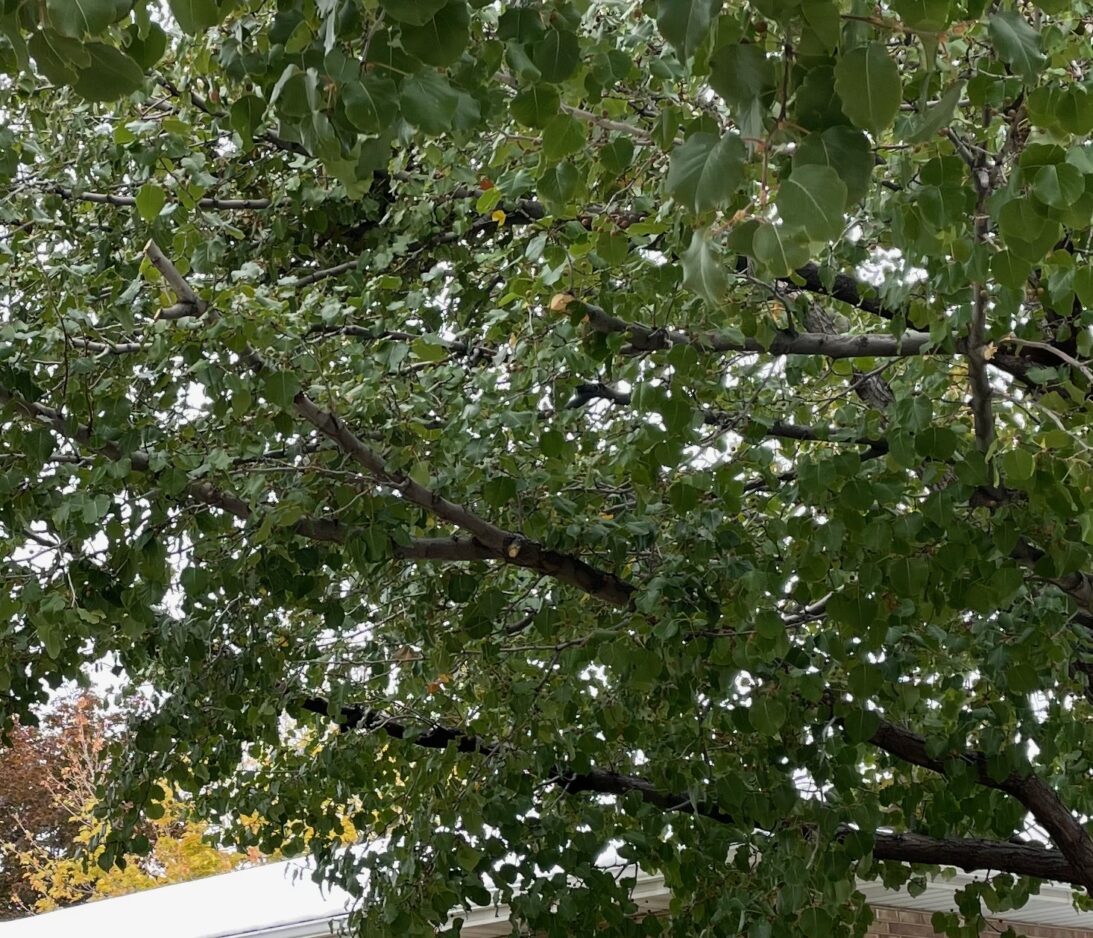Garden Help Desk: Can I save my trees after the heavy snowfall?
- The branches on this Gambel oak were severely bent but didn’t break. The branches are too large to support with a “sling,” If they don’t rise back to their original height within a few days the lowest branches will need to be removed.
- Branches don’t break away cleanly, and sometimes don’t break away completely, creating a potentially hazardous situation.
- The stubs from broken branches in this flowering pear have clean cuts, but the broken branches should have been cut back to another branch. Leaving long stubs creates problems for the tree and the owner in the future.

Courtesy photo
The branches on this Gambel oak were severely bent but didn't break. The branches are too large to support with a "sling," If they don't rise back to their original height within a few days the lowest branches will need to be removed.
The snow last week made the branches on my trees bend and some of them broke off before the snow melted the next day. There are a couple of branches that have cracks along the branch, but they didn’t break off. What is the best way to save my trees. How can I fix the cracked branches?
Snow usually isn’t a problem for trees, but when we get an early snow before trees have dropped most of their leaves, or a late snow in the spring while trees are flowering and leafing out, that’s a different story.
Snow can be very heavy. Blossoms or leaves hold more snow than bare branches, meaning added weight on the branches. Branches that are strong enough to support the weight of leaves (even wet leaves after rain), and wind load during storms often can’t support the added weight of the snow. Branches that can’t support the extra weight may bend, breaking off and leaving jagged stubs, or they may split lengthwise. Occasionally, a tree may tip or be uprooted.
Some species are more prone to damage with early snowfall. Silver maple, willows, flowering plum, and some flowering pear varieties are good examples.
You can brush away early snow on shrubs and small trees. Do the lower branches first, then the upper branches to prevent adding weight to the lower branches. Don’t beat or shake them; that could add extra strain on the branches.

Courtesy photo
Branches don't break away cleanly, and sometimes don't break away completely, creating a potentially hazardous situation.
So, what can you do for a snow-damaged tree?
Broken branch stubs should be pruned back cleanly but avoid scalping into the bark on the trunk or scaffold branches. Most trees with supple branches that have sagged, but not split, can be gently lifted and support with a sling made of soft rope or fabric. Leave the branch secured for about 6 weeks.
What about large trees with snow damage? Go ahead and take care of anything you can do with a pole pruner, or from a ladder. If you need to climb up into the tree to do the job, it’s best to hire a Certified Arborist. Branches that look safe to you may have unseen damage and might not support your weight. A certified arborist has the training to go up into a tree and do any needed work safely.
Should you bolt together a branch that has split? That depends. Are there structures, play areas, or other activity areas near the trees? Would the branch create a hazard if it broke sometime after the split was bolted back together? Larger branches should be inspected by a Certified Arborist who has the training and experience to make sure the branch won’t create a hazard.
You can reduce your chances of having snow damage in the future:
- Avoid planting trees with weak or brittle wood.
- Choose trees with good branch structure, avoiding trees with narrow branch angles.
- Don’t over-fertilize. Excess nitrogen can stimulate rapid or long, thin growth that is more prone to breakage.

Courtesy photo
The stubs from broken branches in this flowering pear have clean cuts, but the broken branches should have been cut back to another branch. Leaving long stubs creates problems for the tree and the owner in the future.
We’ve received several questions this month about fall yard care. Here are two questions we’ve written about in the past but are worth repeating.
When should I start pruning my trees and shrubs in the fall? The short answer is that you should not prune woody plants in the fall. The only exception is dead or diseased branches and branches that pose a safety hazard. These should be pruned as soon as they are found. Shade trees need little, if any pruning. The time to do that pruning is in mid-January. Apple and pears trees are pruned in mid-February and stone fruits, such as peaches, plums, and cherries, in mid-March. Most shrubs are also pruned in mid-March. The exception is spring blooming shrubs such as snowball bush, forsythia, bridal wreath, and lilacs. These are pruned as soon as they are done blooming.
Can I still apply a fall fertilization to my lawn? Yes. The late fall application is actually the most important application of the year but do it as soon as possible.






